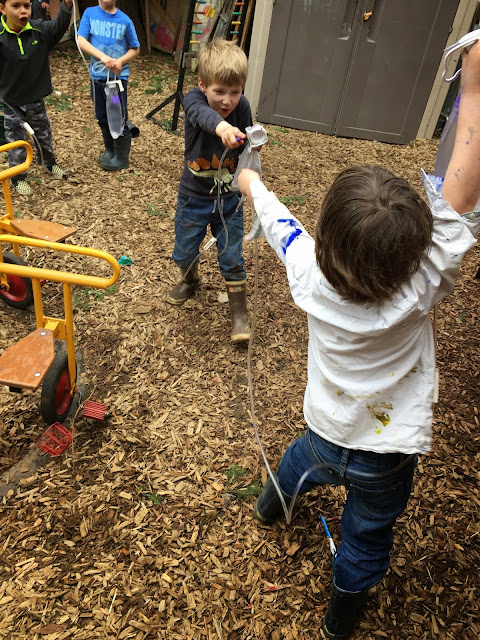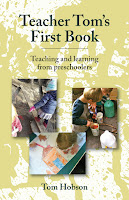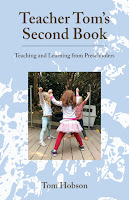"I’d Rather Be Outside, Playing Video Games, With My Friends"
In January of 2000, I began touring kindergartens in anticipation of our daughter moving on from preschool. We had already decided that the local public school was off the table, largely because we knew one of the kindergarten teachers socially and he had told us, flatly, "I would never send my own son there."
I wasn't yet Teacher Tom, but after two years of attending cooperative preschool alongside our girl, I at least had an idea about what I was looking for. I knew I wanted to find a place where social-emotional learning was emphasized, where play continued to stand at the center, and where academic-style instruction was minimal. One of the first schools I toured, the school that our friend the kindergarten teacher had actually chosen for his own son, was very proud of its computer lab. I'll never forget how the director of admissions executed the "reveal," swinging the door open with a kind of ta-da gesture. These were the days when laptops were still considered gimmicky. What we saw was a room with a couple dozen matching desktop computers rigidly lined up on desks. I was told that our daughter, if she enrolled here, would get to spend at least three hours a week in that grim room.
At the time, I didn't know enough to be appalled. Instead, I felt as if they were trying to solve a problem we didn't have. I had no concerns about my middle-class American child learning to use a computer. This was the generation growing up with them, after all, the way my generation had grown up with television. Even then, I was aware that these labs (and several of the schools I toured proudly showed me theirs) were going to very quickly become a joke to a generation growing up immersed in computer technology.
Little did I know that Indian computer scientists Sugata Mitra was thinking similar thoughts. Just a few months earlier, he had installed a computer in a kiosk in an Indian slum that was designed to be freely accessible to the local children, most of whom were not attending any sort of school at all. Within hours, the kids, with no instruction at all, were surfing the internet. Six months later, hundreds of these kids were functionally computer literate, sending emails, operating software and games, and even doing a bit of troubleshooting. They even came up with their own terminology for what the things they were discovering. This experiment lead Mitra to install computers throughout India in what came to be known as the "Hole in the Wall" project.
At the time, adult people were amazed. After all, these new-fangled computer thingies were complicated, cutting-edge technology, yet these uneducated street urchins figured them out in no time at all and with no help from teachers.
As Mitra and his team tweaked and tested these hole in the wall computers, they found that computers installed indoors didn't produce nearly the same results. They also found that sharing the computers, rather one-person-per-computer, was essential to the learning process. That's because when left to their own devices, the children relied upon one another. It wasn't a process of each child learning things on their own, but rather of one child figuring something out then sharing it with all the other children in a process that I've come to think of as "viral learning."
Over my years as a preschool teacher who eschewed computer technology in the classroom, I've observed this viral learning process again and again.
Mitra also discovered that if adults were supervising this process, the process stopped happening, especially if they tried to instruct. I've observed this phenomenon as well.
Some have tried to assert that Mitra's findings, which are truly amazing, reveal something about computer technology, but from where I sit, it clearly shows us the centrality of both social and self-directed learning. This is how humans have educated themselves throughout our 300,000 years as a species. We make a huge mistake when we set up school like those outmoded computer labs, indoors, with students alone at their desks, eyes forward, and lips sealed. We are meant to learn together and through our own curiosity.
Inspired by paragraph in Peter Gray's book Free to Learn, I went through a phase when I would ask children if they would rather be indoors or outdoors. Virtually all of them answered "outdoors." Then I ask them if they would rather be playing video games or playing with their friends. Most chose their friends. But one day a thoughtful boy, replied, "I'd rather be outside, playing video games, with my friends."
That's a boy who wanted to learn at full capacity.
******
"Teacher Tom, our caped hero of all things righteous in the early childhood world, inspires us to be heroic in our own work with young children, and reminds us that it is the children who are the heroes of the story as they embark on adventures of discovery, wonder, democracy, and play." ~Rusty Keeler
If you liked reading this post, you might also enjoy one of my books. To find out more, Click here!
I put a lot of time and effort into this blog. If you'd like to support me please consider a small contribution to the cause. Thank you!



